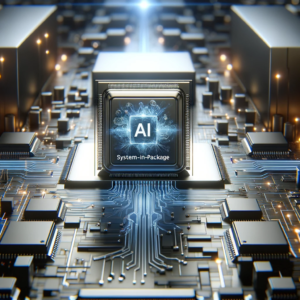
Greg Sheridan
Marketing Manager
Posted on December, 4, 2023
Categories
Recent Posts
- Octavo Systems Unveils the OSD32MP2 Series: Revolutionizing System Design in the Electronics Industry April 9, 2024
- Securing the Future: The Integral Role of SiP Technology in Thwarting Physical Attack Vectors in Embedded Systems March 12, 2024
- Developing Secure Embedded Systems: Best Practices and Strategies March 12, 2024
- Heterogeneous Integration (HI) and System-in-Package (SiP) Technology: A Comprehensive Overview February 20, 2024
- Understanding The Differences Between System-on-Chip (SoC), Package-on-Package (PoP), System-on-Module (SoM), and System-in-Package (SiP) January 17, 2024
AI at the Edge Relies on the Right Hardware
Artificial intelligence (AI) once seemed like a figment of science fiction, but as technology has evolved, many new and exciting applications have arisen. From national security to finance, healthcare, and beyond, AI has the capacity to improve the quality and quantity of data analytics and reduce costs. As the ubiquity of AI technology continues to grow, we see it moving closer to the edge, requiring specialized hardware to ensure that AI-enabled devices can operate and process data efficiently.
What is AI at the Edge?
AI at the edge relies on edge computing – a distributed network of computing devices that exist near the source of data, rather than in a data center. This includes Internet of Things (IoT) devices that could be sensors and smart devices that reside within a home, business, or other location. Because the Internet is a global network, the edge could exist anywhere.
Compared to AI algorithms that run inside of a data center, edge AI can offer a number of important benefits that include:
- Reduced latency since data is processed locally.
- Increased data security since data is processed at the edge and only results are transmitted , reducing the risk of a breach or interception.
- Improved reliability since the AI can run even if connection to a data center goes down.
- Real-time insights since data is processed locally instead of in a distant data center.
Edge AI can also unlock data collected by IoT devices. For example, according to a 2015 McKinsey report, an oil rig with over 30,000 sensors used less than 1% of the data to make decisions. Oil rigs are often located in remote locations with limited IT infrastructure or bandwidth, subjected to harsh conditions. Edge AI can allow operators to leverage real-time data analytics at a local level that can reduce costs, make reliable decisions, and prevent disasters. These devices are useful because they can interpret physical data such as sound, language, temperature, and other metrics that can help save lives. Without edge AI, these algorithms would be impossible to run because of bandwidth, latency, and privacy limitations.
Edge AI Applications
The use of AI in edge locations has nearly endless potential. From healthcare settings to factories and in the energy sector, AI technologies can improve operations. Here are a few examples:
 In the energy sector, AI technologies can be used to monitor power grids, utility poles, and plants to monitor for disruptions in power supply or leaks to prevent unplanned power outages or hazardous conditions. Edge AI reduces the amount of bandwidth required, only transmitting if there is a problem.
In the energy sector, AI technologies can be used to monitor power grids, utility poles, and plants to monitor for disruptions in power supply or leaks to prevent unplanned power outages or hazardous conditions. Edge AI reduces the amount of bandwidth required, only transmitting if there is a problem.- In healthcare, wearable devices can analyze important patient data and provide real-time insights to physicians, allowing the doctor to respond to patient needs efficiently, and identify potentially life-saving interventions. Still, health information is protected since it is processed locally by the edge AI device.
- The manufacturing sector can rely on AI devices to analyze equipment data to predict when the equipment will need to be repaired, which can prevent downtime and create efficiencies within factory operations. Edge AI devices can be easily installed on existing devices without having to invest in expensive infrastructure.
Powering the Edge
Traditional AI algorithms run on large servers and require significant computational power, making data centers their ideal hosts . When it comes to AI at the edge, both algorithms and hardware need to be modified to support the processes carried out on smaller, power-constrained devices. These devices also must be reliable enough to work under harsh conditions without failing and have a long lifespan.
When designing systems that utilize AI at the edge, Octavo Systems System-in-Package (SiP) products can speed up your development. We provide a number of devices so you can pick right processing capabilities and power to support your varying AI needs and power budgets. Our SiP devices integrate the necessary supporting components so you can focus on developing your AI application, not the processor system. Octavo Systems SiPs are the smallest solutions on the market, allowing companies to integrate edge AI into new form factors.
If you’re interested in exploring how a System-in-Package can be applied to edge AI applications, please reach out to our team so we can help you find a solution that is right for your needs.
Resources:
- https://www.brookings.edu/research/how-artificial-intelligence-is-transforming-the-world/#_edn2
- https://www.ibm.com/cloud/what-is-edge-computing
- https://blogs.nvidia.com/blog/2022/02/17/what-is-edge-ai/
- https://www.techtarget.com/searchenterpriseai/definition/edge-AI
- https://developer.nvidia.com/blog/edge-computing-fuels-a-sustainable-future-for-energy/
- https://community.hpe.com/t5/tech-insights/revolutionizing-healthcare-with-ai-at-the-edge/ba-p/7158215


